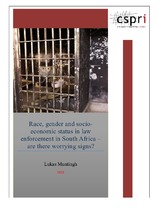| dc.description.abstract | In the South African context the right to equality has particular significance given the country’s history of statutory unfair racial discrimination. This paper investigates, based on quantitative data, how different sub-sets in the South African population experiences law enforcement. Accepting that formal and procedural discrimination according to race was entrenched under apartheid, especially in
law enforcement, the paper enquires if different population sub-sets experience different criminal justice outcomes. Despite shortcomings in the data, there is sufficient evidence to indicate that there is reason to be concerned and that further research is required.
The most reliable evidence of different outcomes in respect of race and gender is the profile of the prison population. Coloured people (adults) have a much higher rate of imprisonment (1932/100 000) than any other population group. Africans (adults) are imprisoned at a rate of 1042/100 000 while Indian and White adults are imprisoned at a rate of around 160/100 000. The high imprisonment rate
for the Coloured population requires further research, but there is reason to conclude that the reasons are (at least) historical in nature as a result of the use of forced prison labour in the Western and Northern Cape and the high levels of institutionalisation of Coloured boys by the previous regime after WWII. The different population groups and genders also experience pre-trial detention differently, with Coloured females standing the highest chance of being detained pre-trial and White females the lowest chance. Although arrest data is not available per population group, a number of observations are made. The majority of the 1.6 million arrests made in 2011/12 were for non-priority crimes. If women and children are excluded from the arrest data it was calculated that one out of every 13 South African adult men were arrested in 2011/12. Arrest and detention place poor people at the risk of further marginalisation and exclusion, and when arrests and detention are concentrated in particular geographical areas, the effect becomes structural and inter-generational in those areas.
There is little doubt that poor African and Coloured South Africans experience law enforcement, and ultimately the risk of pre-trial detention and imprisonment, very differently from Indians and Whites. Transforming the criminal justice system would require that the performance of the police and courts be assessed to determine why the trends created during apartheid apparently still persist and what
steps need to be taken at policy and practice levels to turn this around. Twenty years after the end of apartheid it is simply not acceptable to practice criminal justice without asking questions about how the poor and historically disadvantaged are affected by the system that is supposed to make society safer. | en_US |

